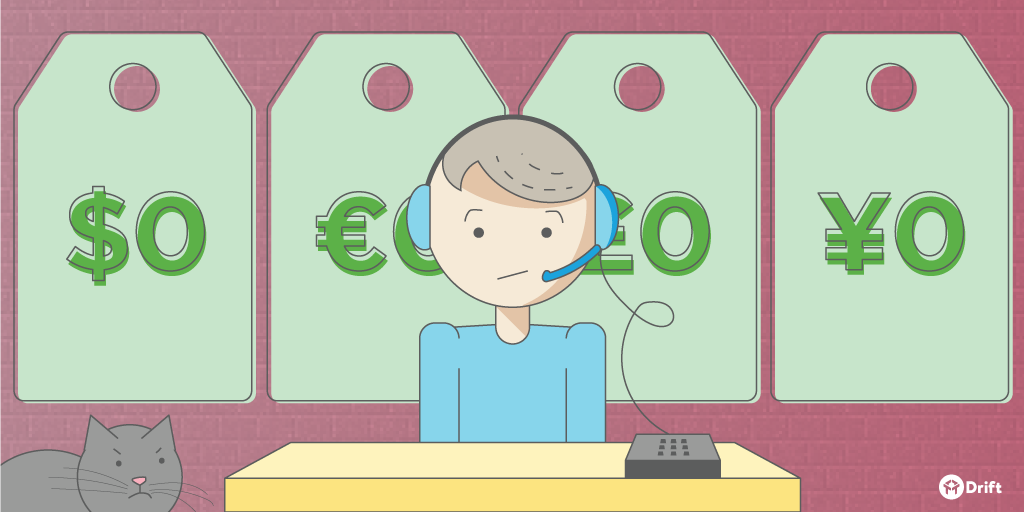
On the face of it, this sounds like a woefully stupid idea: Hiring a team of sales reps to sell a free product — as in a product that has a price tag of $0. (After tax, it’s $0. Adjusted for inflation? $0. Live in the Eurozone? You’re looking at €0.)
As a business, why the heck would you pay sales reps to drive adoption of a product that costs the end user nothing?
And on the other side of that equation, why in Glengarry’s Glen Ross would a sales rep want to work for a company that’s giving its product away?
From a compensation perspective, wouldn’t it make a whole lot more sense for a sales rep to want to work for a company that actually charges something (preferably, money) for its product?
Most of the sales reps I know derive a significant chunk of their income from commission, which is usually based on the dollar value of the deals they close. But if a company’s core product is free, how do sales reps at that company get compensated? How do they stay motivated? And more generally speaking, what do those sales reps actually do?
For the answers to these questions, and for an in-depth look into how sales reps function in a freemium sales environment, keep on reading. There are insights sprinkled throughout from some really smart people — specifically, these really smart people (whom we interviewed exclusively for this story):
- Codeship‘s VP of Sales, Jack Drew
- Help Scout’s Head of Sales, Tim Thyne
- Onshape’s Director of Inside Sales, Chris Essler
PS. We’re building messaging software for sales and customer success. Click here to learn more.
Part 1: The Paradox of Selling a Product That Sells Itself
The “freemium” label can be applied in a variety of circumstances, but it usually refers to a business that brings in revenue via one of the following avenues:
- selling premium/expanded versions of a product (e.g., Slack selling “Standard” and “Plus” packages),
- selling additional features or functionality (e.g., Skype selling “Skype Credit” for making international calls),
- selling complementary products (e.g., iTunes selling music), or
- some combination/hybridization of the options above.
(Note: When it comes to free media products, selling ad space and/or selling information about user behavior are also options for generating revenue. But for the purposes of this story we’re going to focus primarily on freemium SaaS products, which frequently stick to the above options.)
Of course, you can slice and dice the freemium category several different ways. For example, you can differentiate between companies that upsell based on adding more storage space or project capacity, companies that upsell based on adding more seats, and companies that upsell based on adding more tools.
But regardless of the specific monetization route companies decide to take, there’s one advantage to the freemium model that seems to be universal, and, especially in recent years, it’s an advantage that’s been garnering lots of attention.
That advantage?
The freemium model requires little (or, arguably, nothing) in the way of sales personnel.
As Roger Lee of Battery Ventures wrote back in 2014:
Instead of hiring a huge sales force and sending these people out to convince potential customers to buy your product — the way Oracle, SAP, Microsoft, and even Salesforce.com built empires — a freemium model is a perpetual motion machine through which your product “sells itself.”
“How can a product sell itself?” you might be asking yourself. Well, for starters, the product in question needs to be useful, and well-designed, and, at the most basic level, it needs to be … good.
That should probably go without saying, but as Atlassian co-founder and co-CEO Scott Farquhar once commented, having a “good” product hasn’t always been a top priority among software companies:
“Fifteen years ago, as long as you had the best distribution you would win. It didn’t matter whether Oracle was worse than SAP. These days, people are making decisions based on how good the products are.”
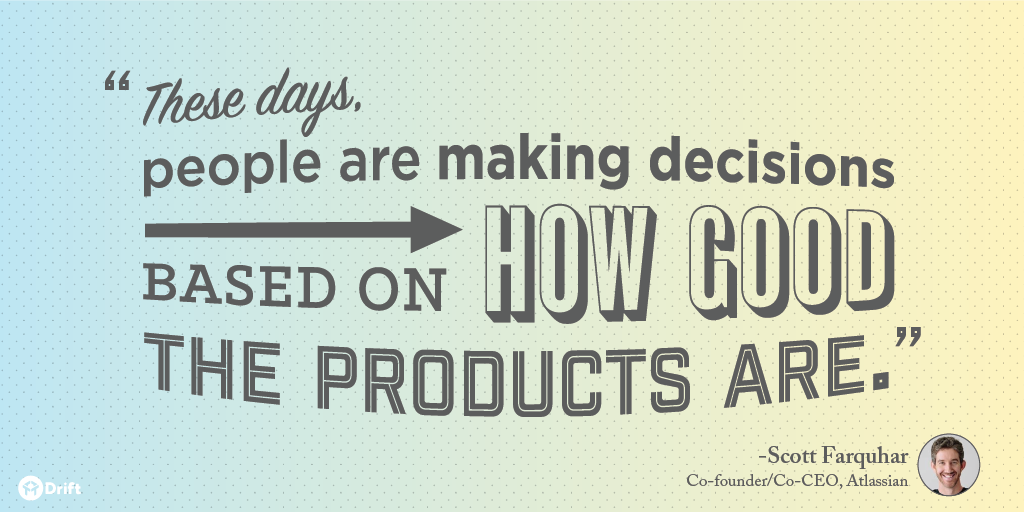
With the freemium model, the goal isn’t to generate and nurture leads, it’s to drive product sign-ups. So instead of convincing people that they could benefit from your product, with freemium you’re putting the product directly into their hands so they can benefit from it.
Or at least that’s the idea.
If people don’t end up liking your product, they’ll stop using it. If they do like it, they’ll keep using it (and — ideally — tell their friends and coworkers about it).
In marketing jargon terms, we’d call the folks in this latter group product-qualified leads (PQLs). They’re the people who you think would be a good fit for a paid version of your product based on the fact that they’ve already used and derived value from your free product. And unlike marketing-qualified leads (MQLs), and sales-qualified leads (SQLs), PQLs are low-touch: You don’t need someone reaching out to them (or bombarding them) with demos, trials, or other bottom-of-the-funnel offers.
As a result, the freemium model can remove a step from the traditional process of product adoption, as people can go directly from considering your product to using it for free — no filling out lengthy forms, no entering credit card numbers, and no talking to sales reps. A name and an email address are usually all that a person needs to get started.
After that, it’s up to the user if her or she wants to pay for an upgrade, but there’s no requirement to do so.
For all you visual learners out there, here’s what the freemium model looks like in business-school-slide format (via MIT OpenCourseWare).
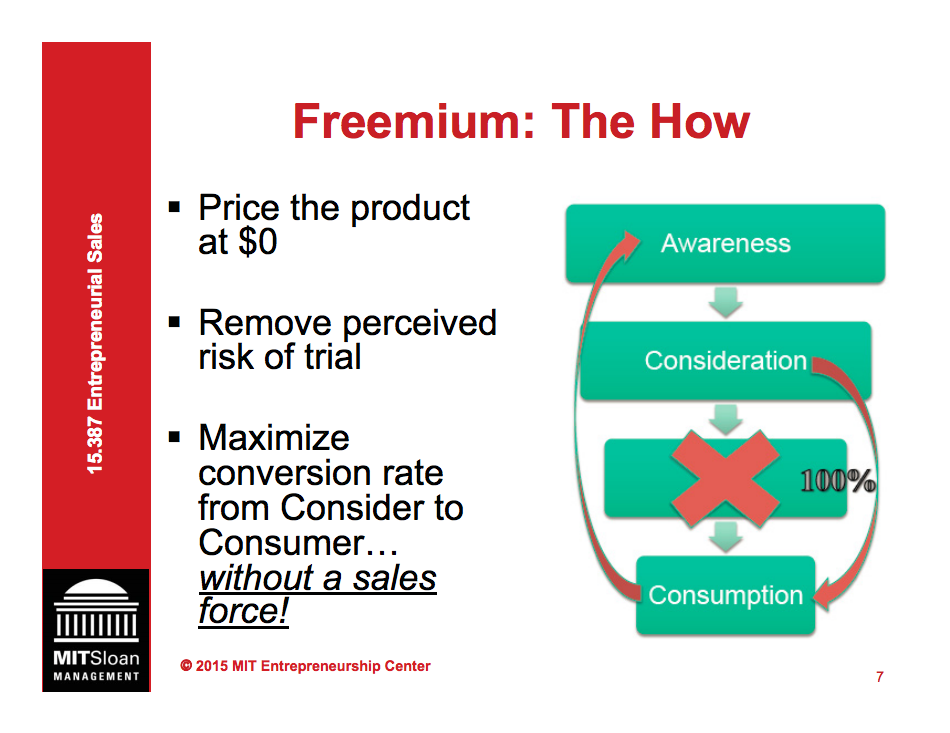
Notice that last bullet point, which is underlined, italicized, and given an exclamation point: “without a sales force!”
It almost sounds too good to be true.
And, arguably, it is.
Part 2: Why Freemium Still Needs Sales
I recently wrote an article about Slack’s growth strategy and how the company earned a billion-dollar valuation without a traditional sales force.
At the end of that story, however, I also mentioned that nowadays, Slack does have a sales force on the payroll. To quote a March 2016 tweet from Slack’s CEO: “We have lots of salespeople and are hiring more!”
So, why did Slack end up altering its successful, sales-less approach to selling, an approach that helped them become one of the fastest-growing companies of all time?
The consensus seems to be that after rapidly saturating the small business/startup market, Slack needed to bring on sales reps to help them tap the enterprise market. And based on the conversations I had with Codeship’s VP of Sales, Jack Drew, and Onshape’s Director of Inside Sales, Chris Essler, this is a predictable trajectory for successful SaaS companies looking to grow beyond what they’ve been able to accomplish with freemium alone.
Here’s Jack:
This is the fourth SaaS startup that I’ve been a part of that has freemium in the model in some way. And also three out of those four had an ecomm channel as well … You can build a really good business utilizing an ecomm channel and not having a sales organization. However, eventually you reach a point of plateauing. You also reach a stage in the evolution of the business where it necessitates bigger revenue leaps, and you can’t as easily or effectively achieve bigger jumps in revenue generation, velocity and scale unless you invest in building a world-class sales team. Leveraging both channels is ideal. Allow smaller deals to sail-through ecomm and the human interaction with sales to maximize ASP (average selling price).
And here’s Chris:
Whether it’s freemium or not, the fact of the matter is that if you plan on competing with an enterprise product at any level or organization above a B2C-type sell, you’re going to need a sales team.
Jack and Chris aren’t alone in their thinking.
In a 2015 article in Business Insider, Jason Lemkin of Storm Ventures laid out some numbers. He said that based on a freemium company earning $10 per paid user/per month, with a conversion rate of 2% (which he cited as an industry average), that company would need 50 million free users in order to reach $100 million in annual sales.
“We’d all love to do freemium because we don’t have to hire salespeople,” Lemkin said, “but … there just aren’t enough businesses in the entire world to get to a $100 million business at freemium.”
As a result, he argues, most freemium companies will inevitably need to install a sales function as they head off to enterprise-land in search of larger deals.
And hiring a sales force at this stage in a freemium company’s growth makes a lot of sense. Because the folks who are responsible for purchasing software for organizations with thousands or tens of thousands employees aren’t likely to use the self-checkout widget on your pricing page. They’re prooobably going to want to talk to a human who can answer questions and explain the product inside and out. From a customer success perspective, having such a human on staff seems like a reasonable idea.
Here’s how Chris explained it:
Our goal is to make our customers successful. Whether they’re paying or whether they’re free, they need to have an incredibly positive experience with the organization, and with the product, and part of that experience for a lot of larger customers needs to be an account manager or a salesperson or an account executive or someone who can get on the phone and have a level of interaction.
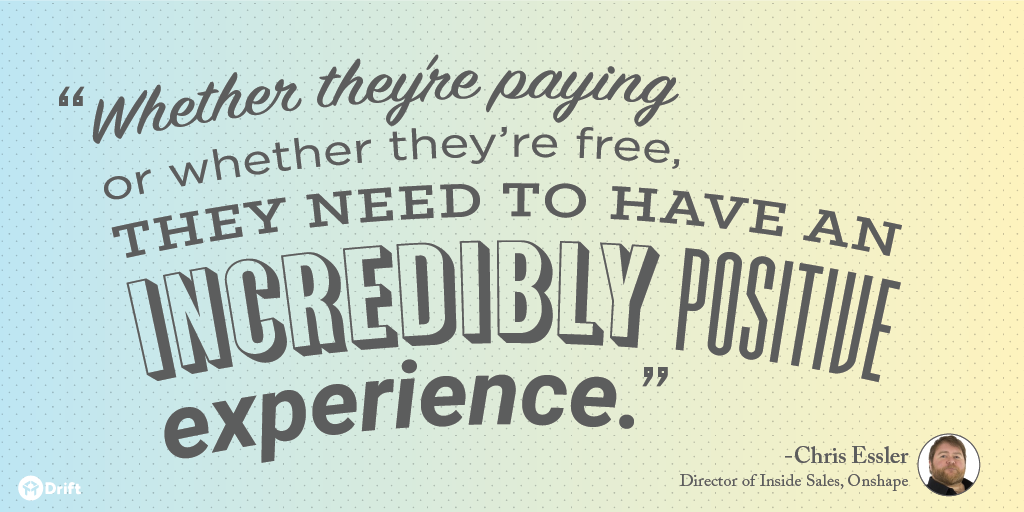
That’s not to say, however, that sales reps are exclusive to freemium companies that have started targeting the enterprise. Any freemium company at any stage can benefit from having experienced salespeople on staff.
In comparison to a more traditional sales operation, however, the function of sales in a freemium environment can sometimes be quite different.
In Drift’s new ebook, How Sales Has Changed, we talked about how with freemium companies, “… it becomes sales’ job to differentiate one free customer from another to figure out who to spend time with.”
Jack from Codeship refers to this practice as “mining the customer base.” And for Codeship it entails using sales tools that can help “getting the product data out of the back-end of Codeship and piping that into Salesforce so that we can get really sophisticated around who are the most engaged free subscribers.”
From there, the Codeship sales team organizes free users into different clusters based on their varying levels of engagement. Sales reps can then reach out to specific clusters with targeted product offerings.
LinkedIn is another example of a company that does this: They identify clusters of free users and target up-sells toward them. As LinkedIn’s VP of Enterprise Business Development, Scott Roberts, told Inc. back in 2013:
Less than 1% of members pay us. We leverage the data from the free power users, and look for clusters of activity. Then we build a marketing and functionality focus around the clusters. That is one of the ways that we got started on [LinkedIn’s valuable] recruiting products.
And here’s Roger Lee also explaining how the “clusters” technique can work, this time in regards to selling into the enterprise:
Salespeople simply look for clusters of active users of the freemium product in an enterprise account; those customers are likely getting value, so they’re good candidates for an up-sell.
These practices, mining the customer base and identifying clusters, are central to freemium sales. And they help give sales reps a well-defined purpose within a freemium organization. Instead of being responsible for bringing in new buyers, freemium sales reps can be responsible for matching active users with the version of the product that will yield those users the most value — even if that means recommending they stick with the free version.
As Help Scout’s Head of Sales, Tim Thyne, told me, today’s sales reps need to “approach conversations with the mindset of ‘what’s best for this customer’ over ‘how much money will I make/lose if they come onboard or not.’”
Because in the long run, a positive interaction can outweigh the value of a forced sale.
Or, as Tim phrased it:
Building a sustainable business is a marathon, not a sprint — even if we don’t close a customer today; if we provide them a stellar experience then it’s likely they recommend us or come back again in the future.
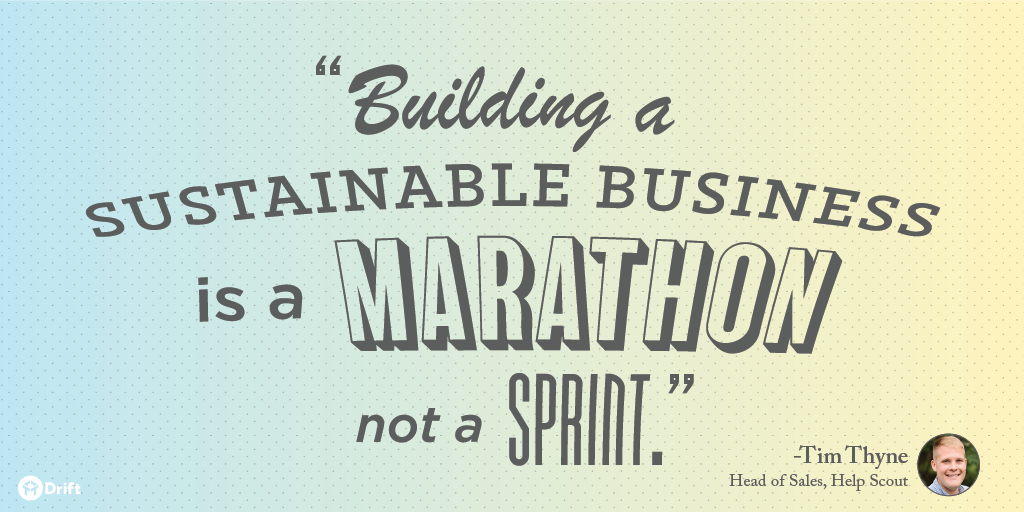
At this point, I think we can safely conclude that sales reps can (and do) have plenty of purpose within freemium companies.
From engaging enterprise prospects, to mining customer data and identifying clusters, it’s clear that freemium sales reps can deliver real value. And in a way, the value that sales reps deliver is part of what customers are signing up for.
As Chris explained:
If you think about it, the technology is only half of what a company is truly buying in this day and age. They’re also vetting, “What’s the support model like? What’s the vision of the company? What’s the brand? How consistent is this organization going to be as far as new feature releases?” And that’s really what the sales team does. Your sales team is essentially a manifestation of the brand and company you’re trying to build.
Part 3: How to Motivate (and Compensate) Freemium Sales Reps
For someone with traditional sales experience, joining a sales force that has a freemium product can potentially be a bit of jolt. Some reps might even go into it thinking that it’s going to be easier than what they’re used to (after all, the folks they’re selling to are already using the product).
Here’s Tim’s take on the situation:
I wouldn’t say the more “traditional” sales rep views their role as less valuable because they are selling into a more qualified pool of leads (people using free product) — they love qualified leads. However, it does seem as though they don’t assume it will be as big of a challenge as what they’re use to, which is not true. ?
(Editor’s note: That emoji is absolutely part of the quote.)
For Tim, the keys to motivating his sales team at Help Scout include focusing on the customer, encouraging teamwork, and, of course, offering competitive salaries.
Not included on that list? Paying commission based on deals closed.
As Tim explained:
We enable you to do your best work, stay focused on the customer, and pay competitively. Although it’s not commission, it’s equivalent and in a lot of cases a higher base salary than your OTE (on-target earnings) would be in “traditional” sales. All we ask is that you do what’s best for the customers and our philosophy is if we we do that, we’ll win.
Tim also highlighted three benefits of forgoing commission-based sales compensation:
- Lead assignment is much easier and there isn’t conflict around who gets assigned what.
- Team members can loop in or pass off a deal to a teammate with more domain expertise if necessary and not worry about losing/sharing commission.
- It’s very operationally efficient.
No one at Slack works on commission, so you don’t have to worry about anyone selling you on a pricing plan you don’t need. We’re simply here to help you have the best experience possible.
[Codeship] sales reps build their own book of business and they retain those customers. As such, even if they close them for a modest dollar amount, which would still be higher than ecomm deals, that goes into their book of business. And then, again, it’s all about establishing the path to larger dollars. In many cases, that path is by way of getting them to sign up as a customer, fostering engagement with the product, and allowing the product to deliver value.
From there, our pricing model is structured in such a way that our path to the bigger deals is really “land and expand.” It’s all about getting them in the door and establishing a connection with our trusted advisor sales reps. A majority of our large customers start smaller and then move to a more substantial investment.

Now, you could read this and think: “See, by assigning commissioned sales reps to specific accounts, you’re incentivizing those reps to upsell like crazy … that’s bad!”
But you could also argue that Codeship’s land and expand model actually incentivizes sales reps to develop stronger relationships with their customers, since reps are responsible for the success of specific customers throughout the entire customer lifecycle. If reps tried to force their customers into unnecessary upsells, those relationships could become damaged, and reps might risk losing the entire business as a result. Hence, reps have an incentive to always deliver an amazing experience — even if their underlying goal is expansion.
The debate over whether or not companies should pay sales reps commission continues to be a healthy one. At the extremes, the arguments for and against it usually break down something like this:
If you’re for commission, you’re for a hungry, competitive sales force that can consistently hit and exceed monthly, quarterly, and yearly revenue goals. You view a commission-free sales model as, at best, slow, and at worst, a Kumbaya circle where no one has any drive and nothing gets done.
If you’re against commission, on the other hand, you’re for a sales force that puts the customer’s needs ahead of revenue goals, and that values collaboration over competition. You view the traditional, commission-based sales model as, at best, a short-term revenue solution, and at worst, a barbaric institution that leads to negative customer experiences and, later, churn.
Of course, the reality of the situation isn’t so black and white. In some cases, commission might be exactly what’s needed to energize a freemium sales team. In other cases, commission-free might be the way to go. The compensation model that works best for your sales organization will depend on your own unique set of circumstances, including your industry, your target market, as well as the specific flavor of “freemium” your company decides to use.
That being said, I’d hate to leave you with one of those so-in-conclusion-everything-is-really-complicated-and-there’s-no-clear-answer-here endings. So instead of doing that, I’ll make this closing declaration:
Regardless of the sales compensation model you go with, one of the best things you can do as a freemium company in order to motivate sales reps is to build an amazing product. If you build a product that people love, a product that’s able to get initial traction based on positive user experiences and word of mouth, your sales reps will feed off that energy.
Best of all, it’s a virtuous cycle: Your amazing product attracts new users and, even if they don’t become paying customers, sales reps can learn from their behaviors and glean insights for making the product, as well as the sales process, even better.
To quote Chris from Onshape:
When you think about what grows a company, it’s not revenue at first. It’s successful customers. It’s getting people to buy into the vision … Revenue will come. If you have built the right product, for the right market, revenue will come. But what can’t come soon enough is adoption. Because adoption lets us understand usage, and it lets us understand how we want to continue to grow and what direction we want to take the product, and what direction we want to take our marketing and sales efforts.
Ultimately, the product is the foundation on which all aspects of a freemium business stand. Take that away, and even the best sales reps in the world won’t be able to find success.
It’s like Chris told me:
Building a sales team to go out and conquer the world is easy: We hire someone like me, we hire a couple of other senior people, and we build the empire. But you can’t be going out there trying to build an empire on tooth picks and promises.



